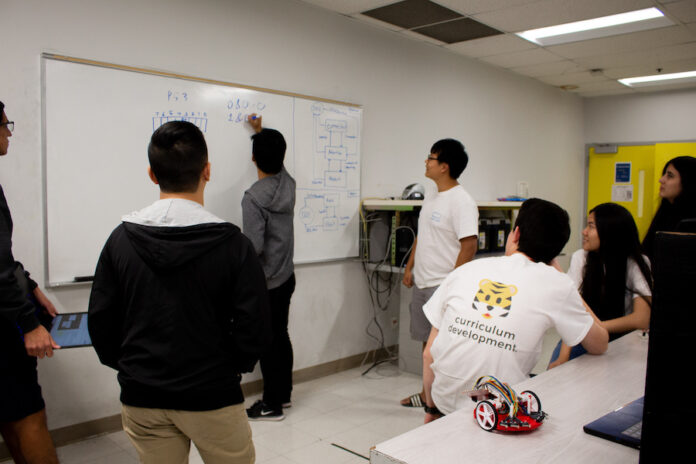UC Davis students organizing electrical engineering program to make grade school robotics more affordable, accessible.
Undergraduate students at UC Davis are developing a new electrical engineering program for high school students across the Sacramento area. These students will receive robotics kits this month and begin a 10-week learning experience that will culminate in a robotics competition at UC Davis on May 5. The project is called natcar.org and it is the brainchild of second-year computer engineering major Dong Gyum “Daniel” Kim.
Since 1994, the UC Davis Department of Electrical and Computer Engineering has held an annual competition called NATCAR. Natcar.org is an extension of the pre-existing undergraduate program. Teams build model cars from basic electrical components and rely on sensors and autonomous algorithms to guide their car around a course made of white pieces of tape.
Over the summer, Kim decided he wanted to create the natcar.org program to make high school robotics more practical. In the early stages of development, Kim and his team of UC Davis students noticed a trend when they spoke with high schools about introducing competitive robotics.
“They were saying they didn’t have the money,” Kim said. “Another thing we ran into was that there were no teachers to teach it.”
Affordability and accessibility became the two defining obstacles that the program would attempt to tackle. The answer to the affordability issue was solved by using the existing NATCAR kits. The kits for the competition, which are sold by Texas Instruments, are around $100.
“NATCAR is unique because it’s relatively inexpensive compared to a lot of other programs,” said Avery Turk, a first-year computer engineering major who is helping to develop the program.
Many other high school robotics have considerably higher startup costs. Vex Robotics, a popular high school robotics competition sells starter kits for $599.99 according to their website. Pitsco sells a $709.95 competition kit for the FIRST Tech Challenge, another popular option for high school robotics. These other robotics competitions emphasize physical variation in the design of the robots, while NATCAR is more focused on the computer programming and electrical engineering, keeping costs comparatively low.
The natcar.org team has worked all quarter to create an online curriculum that will be available to high schools and individuals who sign up on the program’s website. The natcar.org organization has also arranged for UC Davis electrical engineering students to be available in an online forum, so teams can ask questions and receive help when they get confused. They hope this will make the program accessible to high schools who can’t afford to hire dedicated teachers. The easy-to-understand program will also support individuals who want to participate but don’t have the support of their school.
“It’s explained in a way that people without experience are able to learn,” said Katherine Tran, a first-year electrical engineering major who is working on the curriculum.
The team was intent on making sure they did not skip steps in their explanation of key topics. They wanted the high school students to understand how the algorithms control the most basic circuits in the model car.
“So, we go from the volt and the current lighting up an LED,” Kim said. “We then move on to controlling that through very low-level code, and the curriculum keeps going and builds on top of things to make it more abstract, and by the end, they are just designing algorithms.”
The team also wanted to make their curriculum broad and encompassing in order to expose students to all aspects of electrical and computer engineering.
“I think giving them this opportunity allows them to see if they have an interest toward CS [Computer Science], CE [Computer Engineering] or EE [Electrical Engineering,]” said Brandon Trong, a first-year computer engineering major. “It allows them to choose early.”
Written by: Peter Smith — science@theaggie.org






